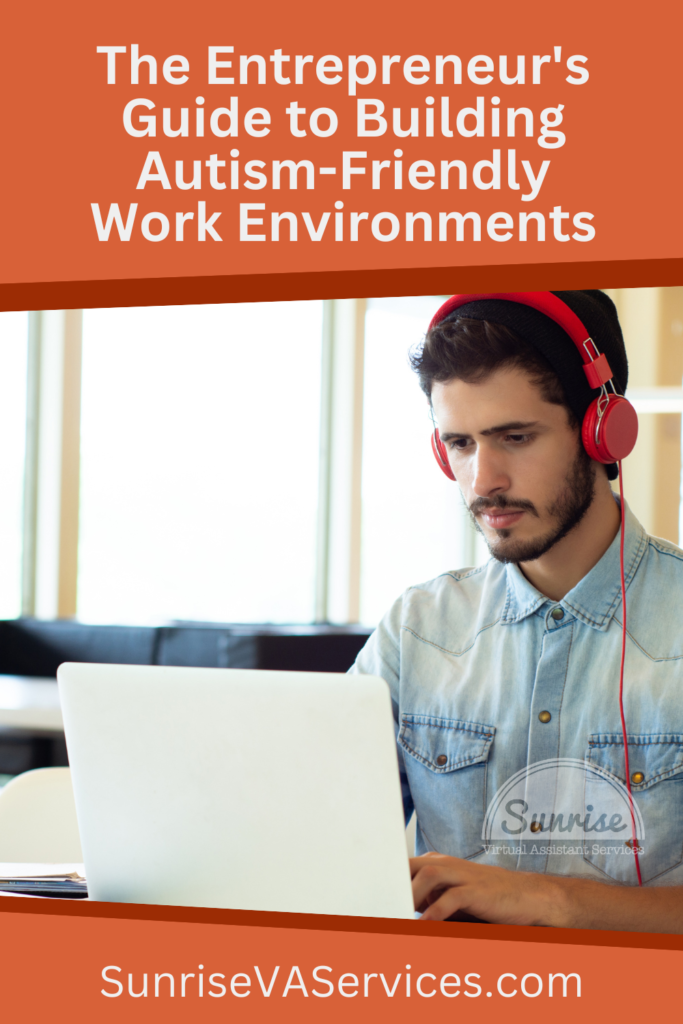Creating autism-friendly work environments is not just about inclusivity; it’s a step towards harnessing a diverse range of talents and perspectives that can drive innovation and growth in any business.
This quick guide is designed to help entrepreneurs understand the importance of adapting their workplace practices and culture to become more accommodating and supportive of individuals with autism. By doing so, businesses contribute to a more equitable society and benefit from the unique skill sets and insights that neurodiverse individuals bring to the table.
The following sections will explore practical strategies and recommendations for building a genuinely autism-friendly workplace.
Keep reading to learn how you can transform your work environment to be more inclusive!
Creating Autism-Friendly Work Environments
Benefits of Accommodation
Accommodating autistic employees brings multifaceted benefits to the workplace:
- Cultivating a culture of inclusivity and diversity is essential to outperforming homogenous teams and boosting creativity and innovation. Diverse team members have evident advantages, as it brings a multitude of perspectives and problem-solving strategies to the table, thereby enhancing overall team performance.
- Companies must make reasonable workplace accommodations for neurodivergent individuals, as this can significantly improve employee satisfaction and retention. While initial costs may be associated with implementing these accommodations, the long-term benefits far outweigh these expenses. Neglecting to provide such support can lead to a disengaged workforce and high turnover rates, resulting in some increased costs associated with training new hires. Therefore, companies must prioritize the needs of all employees, including those on the autism spectrum, to foster a loyal and dedicated workforce. Reasonable accommodations can actually enhance team dynamics, as they promote a culture of understanding and respect.
- Businesses that prioritize accessibility and inclusivity not only improve their reputation but also expand their customer base and attract top talent who value social responsibility. This is a win-win situation where businesses can make a positive impact on society while reaping the benefits of increased success.
It’s important to recognize that hiring neurodiverse employees can tap into an underutilized talent pool, bringing a range of unique skills and strengths to the workforce.
These skills are not just different; they are exceptional. They may include exceptional memory, heightened attention to detail, or specialized knowledge in particular fields. This diversity of skills can genuinely enrich a company’s capabilities.
By adapting workplace practices to include accommodations for individuals with autism, businesses gain a competitive edge and contribute to a more equitable society. They position themselves as forward-thinking, inclusive organizations that attract top talent and resonate with diverse customers.
This is a powerful way for businesses to positively impact beyond their walls.
Strategies for Building Autism-Friendly Work Environments
Creating a workplace that is friendly for individuals with autism is critical for fostering inclusion and maximizing the potential of all employees while also ensuring that individuals with autism feel valued and supported.
Let’s dive into some strategies any company can incorporate for autism-friendly work environments.
Physical Adjustments
There are several ways organizations can create accomodations for an inclusive environment for autistic people, like;
- modifying lighting, sounds, and sensory stimuli in the workplace
- ensuring an autism-friendly environment is comfortable and non-threatening (to avoid anxiety and sensory overload).
This may include making accommodations such as providing noise-canceling headphones or designated quiet rooms (away from loud noises) for employees who have sensory sensitivities.
One recommendation for creating a comfortable and inclusive work environment, is to adjust lighting to avoid harsh illumination. This can involve using softer, more natural lighting sources where possible and enabling employees to control the lighting levels of their personal workspaces.
Communication
It’s important to acknowledge that people have diverse communication styles and needs. For instance, some individuals on the autism spectrum may feel more comfortable with written communication than verbal.
Therefore, it is essential to provide flexible work schedules or communication styles that can be tailored to an individual’s specific needs. This approach can help create an inclusive and supportive work environment that values and respects the differences of its employees.
By recognizing and accommodating varying communication styles, individuals can feel more comfortable and confident with social interactions, and in their ability to communicate effectively in the workplace.
Education & Training
In addition to making physical adjustments, such as modifying the workplace environment to accommodate autistic individuals, it’s also essential to cultivate a workplace culture that values diversity and fosters understanding. This means creating an environment where employees feel comfortable and supported, regardless of their background or condition.
Effective communication is the cornerstone of success. To achieve this, it’s crucial to educate and train all employees on how to work effectively with autistic colleagues. This additional training should focus on developing skills such as communication, empathy, and understanding. For instance, employees could learn how to communicate in different ways with autistic adults and how to recognize and respond to sensory input and communication differences.
Implementing sensitivity training for all staff is a pivotal step towards creating an autism-friendly workplace. Sensitivity training sessions are designed to sensitize employees to the challenges faced by their autistic colleagues and to teach strategies for supportive interaction. These sessions serve a dual purpose: they not only illuminate the difficulties that individuals with autism may experience in the workplace but also foster an environment of respect, empathy, and understanding among all employees.
Through sensitivity training, staff can learn the importance of inclusive language, patience during communication, and the significance of creating an non-judgmental and sensory-friendly workspace.
Additionally, such training can debunk common myths about autism, helping to eliminate stereotypes and prejudices, thereby contributing to a culture of acceptance and support. Instituting regular sensitivity training ensures ongoing awareness and reinforcement of these vital principles, making it a crucial component of maintaining a more inclusive workplace.
Support
Autism-friendly employers can also implement policies and practices that cater to the different needs of autistic workers One practical approach is to provide a mentor or coach to support employees with autism. This ensures they receive the necessary guidance and support to perform their duties effectively. It involves giving clear instructions, breaking down complex tasks into smaller steps, and providing regular feedback to the employees.
In addition, employers can create opportunities for autistic employees to network and socialize with others. This could include organizing team-building exercises, social events, and other activities encouraging interaction and collaboration. Such events can help autistic employees build relationships with their colleagues and develop their social skills, which can help them feel more confident and comfortable in the workplace.
Finally, employers can offer opportunities for professional development and career advancement to employees with autism. This could include training programs, performance evaluations, and career advancement opportunities. Providing these opportunities not only helps employees with autism to develop their skills and advance their careers, but it also helps to create a culture of inclusivity and support in a friendly work environment.
By taking proactive and thoughtful steps to create an autism-friendly workplace, employers can ensure that individuals with autism feel valued, supported, and able to contribute effectively to the workplace. This benefits not only individuals with autism but also the entire organization by promoting diversity and unlocking the full potential of all employees.
Conclusion
In conclusion, creating an autism-friendly workplace involves:
- Making physical adjustments to the environment.
- Fostering a culture of understanding and empathy.
- Providing ongoing autism training and support for all employees.
- Developing a true understanding of autism itself.
By implementing these strategies, employers can create a more autism-friendly work environment that values and respects individuals with communication and sensory differences, ultimately leading to happier employees and a stronger organization overall.
Let us all strive to create a workplace that embraces diversity and supports the unique needs of all individuals, including those with autism. Together, we can make a difference in the lives of people on the autism spectrum by creating a genuinely inclusive workplace, and supportive environment, for all.
Join Our Community
To further our mission of creating inclusive work environments, we invite you to join AudHD Asset, a dedicated Facebook group for neurodivergent entrepreneurs and small business owners. This group is a vibrant community where members can share experiences, offer support, and exchange resources to foster entrepreneurial success in a neurodiverse world.
Whether you’re seeking advice, networking opportunities, or a supportive space to share your journey, AudHD Asset welcomes you. Click here to join us and become part of a community that understands and champions the unique strengths and challenges of neurodivergent individuals in the business world.


